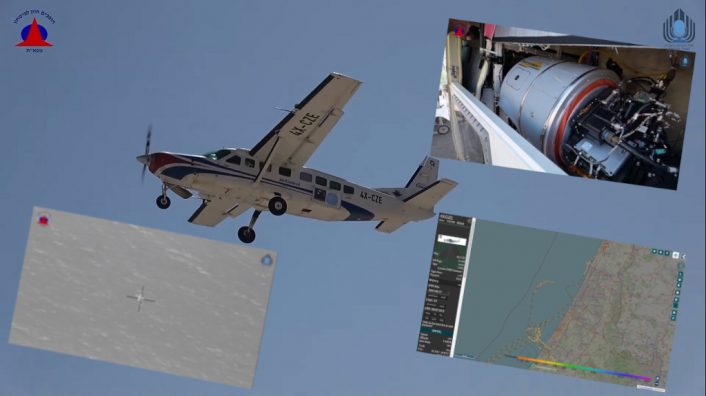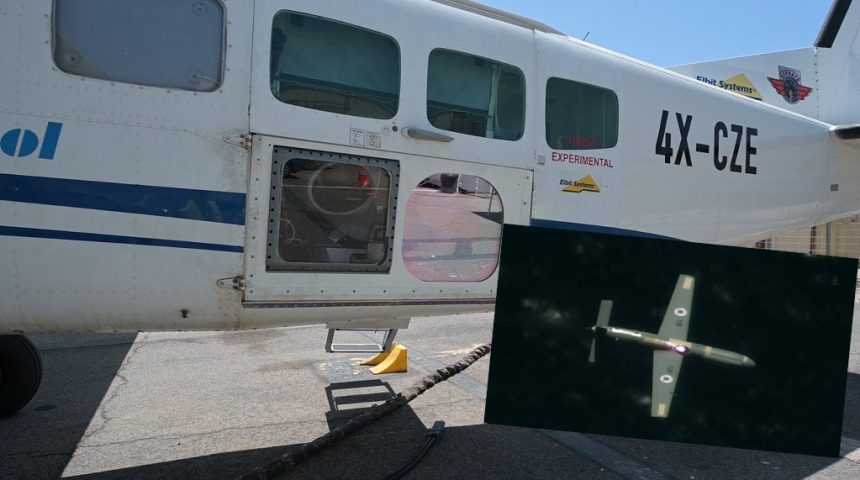The Israeli airborne laser prototype achieved a 100% success rate against target drones over the sea at different altitudes and ranges above one kilometer.
The Israeli Ministry of Defense announced on June 21, 2021 that its Weapons Development and Technology Infrastructure Administration (MAFAT in Hebrew) unit, together with the Israeli Air Force and Elbit Systems, tested a new airborne High-Power Laser system to intercept and destroy several drones at various altitudes and at varying ranges. The first-of-its-kind test was defined as a major technological breakthrough by Defense Minister Benjamin “Benny” Gantz.
Very few details were disclosed, with the Haaretz Newspaper mentioning that the system uses an electrical laser, instead of chemical lasers used during similar tests in the past, and it was able to intercept and shoot down the drones at a range of over one kilometer. However, the work on the prototype is still going on and it is expected to be completed in about three or four years, with the range increased to the tens of kilometers and eventually, by the end of the decade, to the hundreds of kilometers.
During the test, a High Power Laser system was installed on an aircraft and tested in an number of scenarios. It successfully intercepted and destroyed 100% of the UAVs launched during the test. 2/3
— Ministry of Defense (@Israel_MOD) June 21, 2021
Regarding the platform for the laser, the photos published by the Ministry of Defense show that the system was installed at the cargo door of a Cessna 208B Grand Caravan, registered as 4X-CZE and visible on ADS-B tracking websites, which operated over the sea South-West of Tel Aviv last week. Should the system become operational, the goal is to install the laser on transport aircraft at first, and then make the system compact enough to be installed on other smaller platform such as UAVs.
The plan is to use this laser to intercept small drones, rockets and mortar shells while complementing the other Israeli systems, such as Iron Dome, with many advantages. One of the more relevant advantages is the cost, as a laser intercept would cost just few dollars instead of the 100,000 dollars of one of Iron Dome’s Tamir missiles.
Successful interception tests employing airborne High-Power Laser Weapon System. Video: @Israel_MOD (2/2) pic.twitter.com/qkNpRFKvVl
— Elbit Systems (@ElbitSystemsLtd) June 21, 2021
As you may already know, commercially available drones cost few hundred dollars and have been widely used by militants for attacks mainly in the Middle East (but also in South America), prompting many countries to heavily invest in anti-UAV defenses. However, some of the solutions involve an expense of thousands of dollars just to destroy a drone that costs a tenth of that money, which sounds a little disproportionate. The laser employment should even the economic balance between these low-cost threats and the systems used to counter them.
Laser technologies for the defense against rockets and mortars have already been in development in the 1990s in Israel and in the USA, both as joint and independent projects. While the United States went on with the development of these systems, Israel abandoned the idea in the early 2000s to focus on a missile solution, leading to the birth of Iron Dome. Then, two years ago, a technological breakthrough allowed Israel to resume working on the laser, this time the electric laser instead of the chemical laser. A land-based laser defense system is also in the works.

The electric laser, also known as electrolaser, is a directed energy weapon that employs the laser to create an electrically conductive laser-induced plasma channel, which is then used to send down to the target a powerful electric current to kill it. The whole system is powered only by electric current, unlike the chemical laser which uses the energy generated by chemical reactions to reach megawatt power levels.
Similar laser C-UAS (Counter Unmanned Aerial System) and C-RAM (Counter Rocket, Artillery and Mortar) defenses are being developed also in other countries (mainly the USA), but as we already posted here at The Aviationist, airborne lasers are also in development both for offensive and defensive roles.









